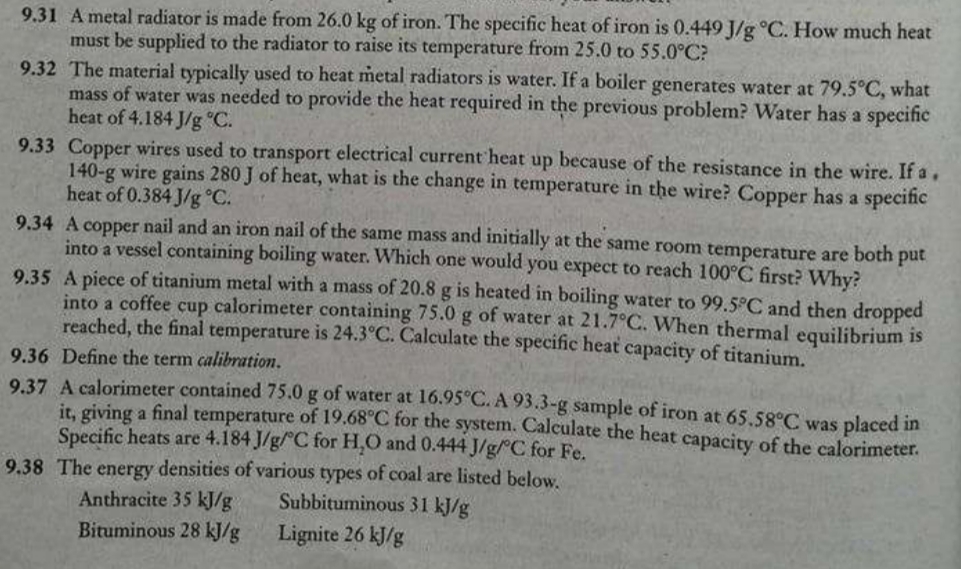9.31 A metal radiator is made from 26.0 kg of iron. The specific heat of iron is 0.449 J/g °C. How much heat must be supplied to the radiator to raise its temperature from 25.0 to 55.0°C? 9.32 The material typically used to heat metal radiators is water. If a boiler generates water at 79.5°C, what mass of water was needed to provide the heat required in the previous problem? Water has a specific heat of 4.184 J/g °C.
9.31 A metal radiator is made from 26.0 kg of iron. The specific heat of iron is 0.449 J/g °C. How much heat must be supplied to the radiator to raise its temperature from 25.0 to 55.0°C? 9.32 The material typically used to heat metal radiators is water. If a boiler generates water at 79.5°C, what mass of water was needed to provide the heat required in the previous problem? Water has a specific heat of 4.184 J/g °C.
College Physics
11th Edition
ISBN:9781305952300
Author:Raymond A. Serway, Chris Vuille
Publisher:Raymond A. Serway, Chris Vuille
Chapter1: Units, Trigonometry. And Vectors
Section: Chapter Questions
Problem 1CQ: Estimate the order of magnitude of the length, in meters, of each of the following; (a) a mouse, (b)...
Related questions
Concept explainers
Rotational Equilibrium And Rotational Dynamics
In physics, the state of balance between the forces and the dynamics of motion is called the equilibrium state. The balance between various forces acting on a system in a rotational motion is called rotational equilibrium or rotational dynamics.
Equilibrium of Forces
The tension created on one body during push or pull is known as force.
Question
Answer item 9.32 only.
"previous problem" stated there refers to item 9.31. Thank you?.

Transcribed Image Text:9.31 A metal radiator is made from 26.0 kg of iron. The specific heat of iron is 0.449 J/g °C. How much heat
must be supplied to the radiator to raise its temperature from 25.0 to 55.0°C?
9.32 The material typically used to heat metal radiators is water. If a boiler generates water at 79.5°C, what
mass of water was needed to provide the heat required in the previous problem? Water has a specific
heat of 4.184 J/g °C.
9.33 Copper wires used to transport electrical current heat up because of the resistance in the wire. If a,
140-g wire gains 280 J of heat, what is the change in temperature in the wire? Copper has a specific
heat of 0.384 J/g °C.
9.34 A copper nail and an iron nail of the same mass and initially at the same room temperature are both
into a vessel containing boiling water. Which one would you expect to reach 100°C first? Why?
9.35 A piece of titanium metal with a mass of 20.8 g is heated in boiling water to 99.5°C and then dropped
into a coffee cup calorimeter containing 75.0 g of water at 21.7°C. When thermal equilibrium is
reached, the final temperature is 24.3°C. Calculate the specific heat capacity of titanium.
put
9.36 Define the term calibration.
9.37 A calorimeter contained 75.0 g of water at 16.95 C. A 93.3-g sample of iron at 65.58°C was placed in
it, giving a final temperature of 19.68°C for the system. Calculate the heat capacity of the calorimeter.
Specific heats are 4.184 J/g/ C for H,O and 0.444 J/g//C for Fe.
9.38 The energy densities of various types of coal are listed below,
Subbituminous 31 kJ/g
Anthracite 35 kJ/g
Bituminous 28 kJ/g
Lignite 26 kJ/g
Expert Solution
This question has been solved!
Explore an expertly crafted, step-by-step solution for a thorough understanding of key concepts.
This is a popular solution!
Trending now
This is a popular solution!
Step by step
Solved in 2 steps

Knowledge Booster
Learn more about
Need a deep-dive on the concept behind this application? Look no further. Learn more about this topic, physics and related others by exploring similar questions and additional content below.Recommended textbooks for you

College Physics
Physics
ISBN:
9781305952300
Author:
Raymond A. Serway, Chris Vuille
Publisher:
Cengage Learning

University Physics (14th Edition)
Physics
ISBN:
9780133969290
Author:
Hugh D. Young, Roger A. Freedman
Publisher:
PEARSON

Introduction To Quantum Mechanics
Physics
ISBN:
9781107189638
Author:
Griffiths, David J., Schroeter, Darrell F.
Publisher:
Cambridge University Press

College Physics
Physics
ISBN:
9781305952300
Author:
Raymond A. Serway, Chris Vuille
Publisher:
Cengage Learning

University Physics (14th Edition)
Physics
ISBN:
9780133969290
Author:
Hugh D. Young, Roger A. Freedman
Publisher:
PEARSON

Introduction To Quantum Mechanics
Physics
ISBN:
9781107189638
Author:
Griffiths, David J., Schroeter, Darrell F.
Publisher:
Cambridge University Press

Physics for Scientists and Engineers
Physics
ISBN:
9781337553278
Author:
Raymond A. Serway, John W. Jewett
Publisher:
Cengage Learning

Lecture- Tutorials for Introductory Astronomy
Physics
ISBN:
9780321820464
Author:
Edward E. Prather, Tim P. Slater, Jeff P. Adams, Gina Brissenden
Publisher:
Addison-Wesley

College Physics: A Strategic Approach (4th Editio…
Physics
ISBN:
9780134609034
Author:
Randall D. Knight (Professor Emeritus), Brian Jones, Stuart Field
Publisher:
PEARSON